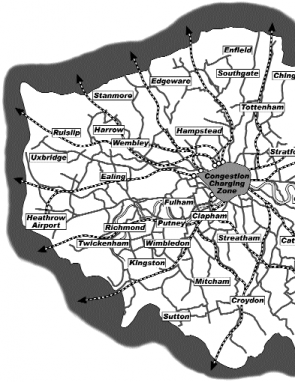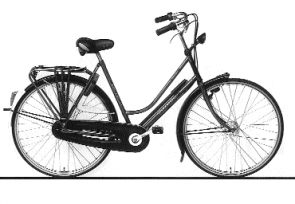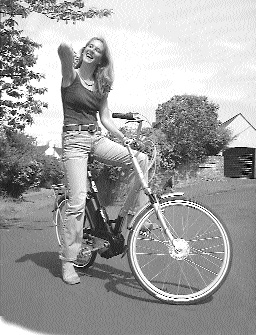
Greater London’s alternative transport map, showing primary railway lines and key cycle routes
1. London Cycle Maps
Transport for London’s excellent cycle maps are essential equipment, whether you’re cycling, scooting or walking into the capital.The maps show official cycle routes in blue (these are of variable quality) and other recommended off- road and on-road routes in green and yellow – these are mostly chosen by London Cycle Campaign members and are generally safe, quiet and direct.
With some careful planning, it’s possible to travel miles across London without sharing road space with cars: Much of the cycle route from Paddington to Whitehall is now traffic-free, and it’s easy to patch together routes from back roads and cycle-friendly parks, just about anywhere in Greater London. British Waterways has finally agreed to allowed cycles back onto key stretches of the Grand Union canal, too.
There are 19 maps in all, covering the whole of Greater London, from the central zone out broadly to the M25. All are available free, although Map 10, covering the key central area, is currently being updated and reprinted, but should be available by the time we go to press.
Downside: Some official routes are poor, but don’t blame the map!
Stockists: Call TfL on 0207 222 1234, or at most cycle shops.
2. Folding bike
(Plus Tube/Rail/River Bus)

A folding bike should be top of your shopping list if you live in London, Greater London, or indeed anywhere else. For those relatively close to public transport, lacking secure cycle parking at home or work, or simply longing for a more flexible travel mode, a folding bike can change your life.The compact machines – in practice, that means Brompton,Airframe or Micro – can be carried on all (yes, all) Underground and mainline train services. If travelling in the peak, it’s worth investing in a bag or cover to avoid oily conflicts with fellow passengers, and it’s worth avoiding central zone tube stations. Most of these involve steps or lifts, and they can be very busy. But as a general rule, a folder allows you to forget the time-consuming hassle of changing from one Underground line to another, or from Underground to bus, because it’s usually quicker to nip out and pedal.
The advantages go on and on: In fine weather, cut out the Underground altogether and cycle home.When public transport fails, leaving passengers trapped, just nip onto the street and pedal home. Hardened motorists can carry the bike in the boot, then abandon the car in a quiet suburban street and pedal in – annoying for those who live there, of course, but cheap and effective.
As a general rule, a good folder, used sensibly with other transport, provides the fastest and most flexible solution to city travel. But which to buy? If public transport and parking space are not major issues, look at 20-inch machines, such as the Dahon range, a Bike Friday, or the Giant Halfway. Of the true compacts, the Micro is fine for occasional use, the Airframe remains an unknown quantity, the Birdy is best for longer commutes on indifferent surfaces, but the Brompton – born, built and refined in London – is undoubtedly the king for most commuters most of the time.
And finally, if you’re a member of the old school – 26-inch wheels, canvas panniers, good enough for grandad, and so forth – you might be influenced by the fact that the Cyclist’s Touring Club has recently elected a Chairman and Vice-Chairman who both ride folding bikes. How things change!
Downside: Folders are relatively expensive machines (don’t cut corners though) and it’s all too easy to become a folder bore (‘How long did it take you? You want a Brompton mate – through the park, two stops on the tube, ten minutes tops, whoosh!’
Stockists: London is the UK centre for folding bike dealers, with half a dozen specialists – see ads in this issue, or try the A to B stockists list on our web site.
3. Commuter bicycle

The Dutch Gazelle Impala - a fairly typical ‘proper’ bicycle
Of course they still exist! Chuck out that sad old Mountain Bike – the tyres are all wrong, it’s dangerous after dark and it absorbs precious energy like a sponge. Good sensible bicycles with lights, mudguards, racks and other essential equipment are available through a number of cycle dealers in London and other cycle-friendly cities. For serious traffic- light credibility, go for a genuine Dutch, Danish or German roadster, but you may prefer something lighter and more sophisticated for the hilly bits. As a general rule, for journeys of up to five miles or so, a bicycle beats everything else hands down.
It’s well worth investing some proper money in a real commuter bike – quality components, suspension (optional) and a light, sprightly frame. Remember, there’s no longer any need to cut corners – £500 spent now will be back in your pocket in well under six months.
Finally, hassle your employer for decent secure under-cover parking. In the era of Congestion Charging, cyclists are the new gold card commuter aristocracy. Demand facilities! If you’re intending to ride to the station, cycle parking has improved a great deal in recent years, but few stations provide secure or covered parking. Another reason to do some lobbying, because thanks to the largesse of his Holiness the Mayor, money will be available, or at least, that’s the theory…
Downside: Bicycles are only allowed on specified rail and Underground services – see our ‘Bike/Rail’ web pages for details. Get a puncture, and you’re on your own.
Stockists: Numerous specialists sell ‘proper’ bikes, but surprisingly few are in London. Once again, A to B is a good place to start, but expect to visit York, Oxford or Cambridge.
…From the foothills of High Barnet to the craggy peaks of Purley…
4. Electric bicycle

Giant Lafree - well-equipped and light
London is situated in a bowl – flat in the middle, but progressively hillier as you travel north or south. If you live beyond Crystal Palace to the south, or Hampstead to the north, an electric bike could be a worthwhile investment. For journeys of more than five miles, journey times should beat all-comers, especially if you work in the congested central area. From the foothills of High Barnet, or the craggy peaks of Purley, you’ll save time, and lots of lovely money, by eliminating other modes altogether. Compared to a public transport season ticket, or Congestion Charge premium, you’ll be in profit in well under a year – electric bikes start at around £500, but expect to pay £1,000 for a good commuter machine. Running costs are generally more than a bicycle, but much lower than the other motorised alternatives.
Of the numerous good, bad and indifferent bikes on the market, only three really shine – the Powabyke, the Giant Lafree and the Heinzmann.The Lafree is well equipped, quiet and light enough to carry home on the train in an emergency, provided you avoid long flights of steps.The Powabyke is poorly equipped, heavy and brutish, but tough as old boots.When buses, cars, trains, mopeds and other bicycles are floundering in the snow, you’ll be at your desk as usual.The Heinzmann Estelle is a quality German machine (say no more, squire), with the marked advantage of recharging in two hours flat.
The electric-assist Holy Grail is a viable folding commuter machine, combining items 2, 3 and 4 in a single lightweight package.This remains some way off, but specialists such as Kinetics, or A goto B of Notting Hill, can supply something state of the art for a price.
Downside: Non-cyclists and cycle enthusiasts alike will accuse you of cheating.
Stockists: Springing up all over, but we’d suggest starting with the Electric Commuter Co, 1308 High Road, London N20, or the Solex Centre, 408 King’s Road, Chelsea, London SW10.
5. Walking
(plus bus/tube/train/river etc)
Used in conjunction with buses and other public transport, walking can get you a long way, reasonably quickly.This has to be the best way to appreciate London’s parks and green spaces and you can do it just about anywhere, anytime without upsetting officialdom. Most bus stops now display real-time info on the whereabouts and routes of buses – that doesn’t stop three coming at once, but at least you’ll be forewarned.
Downside: Somewhat reliant on the vagaries of public transport.
Essential Equipment: Transport for London publishes a free guide to bus routes in central London. Call 0207 222 1234 for a copy.
6. Moped
 These days all mopeds have electric start and some sort of weather protection, with no gears to worry about – just ‘twist & go’.They are very light, easy to ride, and fuss-free. Most are two-strokes but there are a few quiet and economical four-strokes as well – 150mpg here we come! And if you’ve got a full car licence you can ride one straight out of the showroom with no need for further training (not necessarily a good idea). Out on the road, expect to be treated by other traffic as if you’re on a bicycle. Price? The cheapest Chinese imports start at £700, but expect to pay £1,200 upwards for a quality brand.
These days all mopeds have electric start and some sort of weather protection, with no gears to worry about – just ‘twist & go’.They are very light, easy to ride, and fuss-free. Most are two-strokes but there are a few quiet and economical four-strokes as well – 150mpg here we come! And if you’ve got a full car licence you can ride one straight out of the showroom with no need for further training (not necessarily a good idea). Out on the road, expect to be treated by other traffic as if you’re on a bicycle. Price? The cheapest Chinese imports start at £700, but expect to pay £1,200 upwards for a quality brand.
Downside: Parking can be a problem in some areas, and you’re subject to the all the usual traffic laws – drink/driving prohibition for you, MOT and tax for your wheels.
Essential Equipment: Insurance, plus helmet, waterproofs and gloves. Piaggio has produced a motorcycle parking map of London. Price £2.50 from Piaggio dealers, or telephone 0800 20 30 10.
7. Small Motorcycle/Scooter
Not all motorbikes are Harley-Davidsons, Ducatis, Triumphs or BMWs. Shame, but there it is. Seriously, there are lots of sensible, good value bikes out there, and all of them have the jam-busting abilities of two wheels with the speed of a car once out of town.The choice is really between fully automatic scooters (comfy, with built-in weather-protection and luggage) and basic 500cc motorbikes that cost about the same as a 250cc scooter – £3,000-£4,000 for a new one, but there’s lots of choice secondhand. Expect 50-65mpg on a 500cc bike, 75-85mpg on the scoot. For longer commutes, there’s nothing to compare for sheer convenience and fun.
Downside: As for mopeds, but more so. Essential Equipment: As for mopeds, but more so.
8. Micro-scooter
No, don’t laugh – they may be best known as children’s toys, but micro-scooters can be quite useful over short distances. If you’re faced with a walk of up to a mile (on reasonable surfaces) to the Underground station, scooting will get you there a lot quicker, especially if hills are involved, but watch those brakes in the wet…Their use is banned on railway platforms, but they appear to be legal in long passages and covered ways to and from station and Underground platforms. Get to work, and it folds up out of the way.
Downside: Limited range and dubious street-credibility
Stockists: Too numerous to mention
9. Powered micro-scooter
 These machines are either slightly illegal or downright seriously illegal, depending which test case you’ve been following.You’re unlikely to get sent to the Tower on a first offence, but if you decide to travel this way, be prepared for a legal challenge of some description.The more civilised electric variant fills the gap between micro-scooter and bicycle – shortish journeys of one to three miles. Hill climbing is hardly sprightly, but with some muscle assistance, you should be able to get up most gradients. Look for a compact folding machine – if it’s too heavy or awkward to take on the Underground, it won’t be much use to you.
These machines are either slightly illegal or downright seriously illegal, depending which test case you’ve been following.You’re unlikely to get sent to the Tower on a first offence, but if you decide to travel this way, be prepared for a legal challenge of some description.The more civilised electric variant fills the gap between micro-scooter and bicycle – shortish journeys of one to three miles. Hill climbing is hardly sprightly, but with some muscle assistance, you should be able to get up most gradients. Look for a compact folding machine – if it’s too heavy or awkward to take on the Underground, it won’t be much use to you.
For the seriously potty brigade willing to set forth into the cut and thrust of city traffic at 25mph on three-inch wheels and/or upset their fellow citizens on the pavement, the petrol option exists. Other more or less hairy variants include skateboards and roller-skates (yes, really).
Downside: The Met may decide to impound your wheels for your own safety.
Stockists: Visit a micro- scooter outlet, wink and say ‘Got anything with a bit more poke?’.
10. Helicopter
 Ideal companion for a folding bike, a helicopter is worth considering if time matters more than mere money. Landing fees at the not-very-central Battersea Heliport (yes, you’ll need the bike) range from a reasonable £75 plus VAT to £995 plus VAT for a Chinook. (Useful if you’re considering a military coup – and who isn’t these days?)
Ideal companion for a folding bike, a helicopter is worth considering if time matters more than mere money. Landing fees at the not-very-central Battersea Heliport (yes, you’ll need the bike) range from a reasonable £75 plus VAT to £995 plus VAT for a Chinook. (Useful if you’re considering a military coup – and who isn’t these days?)
Unfortunately, ‘copter parking is very much at a premium, so you’ll also need a pilot to fly your machine back out and meet you again after work, for another £75, plus etc etc. Chartering might make more sense. For example, six commuters can charter an Augusta 109 for the day, for around £1,350 plus VAT. Commute time from Stansted Airport (or any useable landing field around London, come to that) is about 15 minutes.
Downside: Stylish, but a bit pricey
Contacts: Battersea Heliport tel 020 7228 0181. Charters (Air Harrods) tel 01279 660800
![]()
